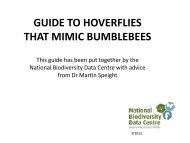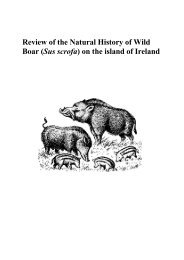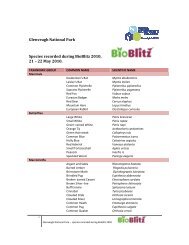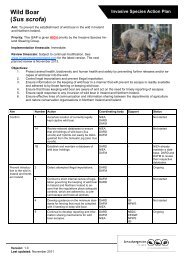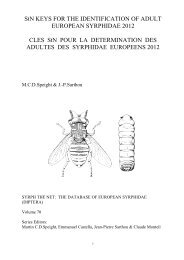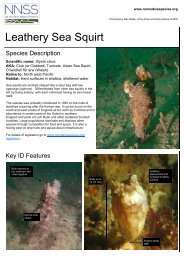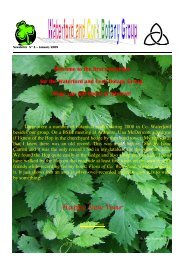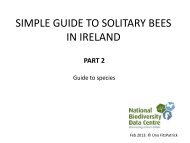StN DATABASE: CONTENT AND GLOSSARY OF ... - Pollinators
StN DATABASE: CONTENT AND GLOSSARY OF ... - Pollinators
StN DATABASE: CONTENT AND GLOSSARY OF ... - Pollinators
Create successful ePaper yourself
Turn your PDF publications into a flip-book with our unique Google optimized e-Paper software.
seasonal flower bed, urban park: area of rotovated, or otherwise maintained bare ground, into which<br />
has been planted various herbaceous plants with decorative flowers, the plants usually being replaced a<br />
number of times during any one year, in order to maintain a display of flowers for as long a season as<br />
possible. CORINE 85.14: Park flower beds, arbors and shrubbery<br />
semi-permanent flower bed, urban park: area of rotovated, or otherwise maintained bare ground, into<br />
which has been planted either tall, perennial herbaceous plants (e.g. Iris, Narcissus) or small shrubs<br />
(e.g. Erica, Lavandula, Rosa) that are left in place for more than one year, often acting as an edging or<br />
backdrop to a seasonal flower bed, or as a hedge or path border. CORINE 85.14: Park flower beds,<br />
arbors and shrubbery<br />
sheep, heavily-grazed improved grassland: cropping of ground vegetation by sheep throughout the<br />
growing season, resulting in reduction in general sward height to less than 2cm.<br />
shingle beaches, coastal beaches: CORINE 17.1, 17.2, 17.3.<br />
CORINE 17.1: UNVEGETATED SHINGLE BEACHES: Shingle beaches devoid of phanerogamic<br />
vegetation. Mediolittoral (intertidal) and supralittoral invertebrate communities can be used to define<br />
subdivisions.<br />
CORINE 17.2: SHINGLE BEACH DRIFT LINES; Cakiletea maritimae p.; Formations of annuals<br />
occupying accumulations of drift material and gravels rich in nitrogenous organic matter; characteristic<br />
are Cakile maritima, Salsola kali, Atriplex spp. (particularly A. glabriuscula), Polygonum spp.,<br />
Euphorbia peplis, Mertensia maritima, Glaucium flavum, Matthiola sinuata.<br />
CORINE 17.3: SEA KALE COMMUNITIES; Honkenyo-Crambion; Halo-nitrophilous perennial<br />
vegetation of the upper beach formed by Crambe maritima, Honkenya peploides and species<br />
characteristic of the regional communities as indicated below.<br />
shrubbery/hedge, urban park: stands or hedges of usually broad-leaved, evergreen, shrubs of 1-3m<br />
height, with dense, ornamental foliage and/or ornamental flowers (e.g. Buxus, Laurus, Ligustrum,<br />
Prunus laurocerasus, Rhododendron, Viburnum tinus). CORINE 85.14: Park flower beds, arbors and<br />
shrubbery<br />
small open area with flushes in forest, forest supplementary habitats: glades and small clearings<br />
within forest, containing helocrene groundwater outflows and usually with a ground cover of tall-herb<br />
communities (see under tall herb communities), though sometimes predominantly grassy with Juncus<br />
and or Carex spp.<br />
Spartina beds, saltmarsh: perennial, pioneer cordgrass (Spartina ) grasslands of coastal salt<br />
muds:CORINE 15.2.<br />
CORINE 15.2: CORDGRASS SWARDS; Spartinion maritimae; perennial pioneer Spartina grasslands<br />
of coastal salt muds.<br />
spring/flush (gen.), running freshwater: running water outflows at their point of emergence above<br />
ground. CORINE 54.1: SPRINGS. For convenience helocrene features (flushes and seepages) are<br />
included under this general category, with limnocrene and rheocrene springs. This category includes<br />
CORINE 54.12: petrifying springs with tufa formations (Natura 2000 category code 7220).<br />
CORINE 54.1: Montio-Cardaminetea i.a.; gushing spring (rheocrenes), springs basins (limnocrenes)<br />
and seepages (helocrenes) and the communities closely associated with them and dependent on the<br />
peculiar microclimatic and hydrological situation created by the spring. These comprise the specialised<br />
spring communities (Montio-Cardaminetea) as well as the fen communities (Caricetalia davallianae,<br />
54.2, Caricetalia fuscae, 54.4) or other communities (Caricion bicoloris-atrofuscae, 54.3, Festuco-<br />
Brometea, 34.3) that are interwoven with them.<br />
CORINE 54.12: Hard water springs with active formation of travertine or tufa. These formations are<br />
found in such diverse environments as forests or open countryside. They are generally small (point or<br />
linear formations) and dominated by bryophytes (Cratoneurion commutati).<br />
spring in forest, forest supplementary habitat: limnocrene and rheocrene springs emerging within<br />
forests, under the tree canopy.<br />
spring in open ground, open ground supplementary habitats: limnocrene and rheocrene springs<br />
emerging in open ground.<br />
38



